Another week, another Madness of Malifaux book not in my mailbox. The good news is it should ship to me this week, so the very next column will hopefully be the very first look at the full book!
In the meantime, we take a break from our regularly scheduled Malifaux programming to look at Wyrd’s large-scale game, The Other Side.
The Other Side of What?
The Breach, obviously! And for those who have been paying attention to the Malifaux lore, the other side of the Breach is… Earth.
The Other Side is set on Earth, rather than Malifaux, and deals with the aftermath of the Burning Man’s ascension. The coming of the Burning Man was foreseen by the madman Ephraim Wade, who wrote the Contiones de Rege Flammae to chronicle his lunatic visions. Wade was locked up by the Extraordinary Cases Bureau of the King’s Empire, but when a flaming effigy appeared in the sky, the ECB realized that Wade might have had a point. They broke him out, and Wade became Adeodatos, the prophet of the Cult of the Burning Man.
The King’s Empire had their hands full dealing with Adeodatos and his mad followers, especially when reality started to buckle and writhing Things began to caper and crawl out from the fissures, but the worst was yet to come. Portals began to open all over London… and immediately spilled out thousands of gallons of seawater. The other ends of these portals were at the bottom of Malifaux’s seas, but the Gibbering Hordes that emerged from them were all too capable of surviving on land. The twisted servants of the Tyrant Meridion, the Hordes invaded London and set the half-flooded city aflame. The King’s Empire and the Guild’s finest magicians battled with the Hordes and their servants for days, and when they finally purged the city, tens of thousands were dead and London was in ruins.

Enough is enough. Abyssinia, a reclusive East African nation, decided that it could no longer stand by and watch the world tip into madness. Unbeknownst to much of the world, the Abyssinians have had a small Malifaux portal for ages, and the Soulstones they recovered formed the basis of their technology. Wielding the most advanced weaponry and powered armor that the world had ever seen, the Abyssinian legions deployed prototype lightning guns and clanking mech suits to bring order to chaos.
And in the shadows, dark forces gather… the spirit-binders of the Court of Two, the nefarious plotters of the Guild, and those that dwell Beyond, clawing at the fabric of reality like a fox scraping at a henhouse door…
Ok, But Seriously, What Is The Other Side?
The Other Side was intended to be Wyrd’s second big miniature game – a full-sized wargame, not skirmish-scale like Malifaux. It was Kickstarted in 2017 and fully funded at more than $300,000, promising four factions at launch with more to come and exciting gameplay that took the core elements of Malifaux and twisted them enough to make something wholly new.
The core component of the game is the Fireteam. A Fireteam occupies an 80, 100 or 120mm base. On each base are individual models, usually 3-5 of them, which function as the “wounds” for that Fireteam. Together, several Fireteams form a unit, and must remain in coherency. Over the course of the game, individual models will die as the unit takes wounds, or be restored through reinforcement. You can also buy Adjuncts (reminiscent of unit attachments from WM/H) that replace one of the models in a Fireteam with a leader model that adds abilities to the unit. Commanders and some individual “solo” type units, on the other hand, form their own Fireteam of one model, while massive Titans stand on their own.
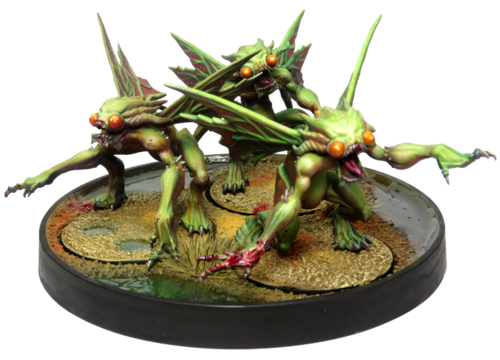
The four Allegiances – King’s Empire, Abyssinia, Gibbering Hordes and Cult of the Burning Man – battle for supremacy, each seeking to capture Earth’s resources for their own. Players pick a number of Commanders determined by the game size, and the Commanders tell you how many points you have available to build your army with. Once the forces are assembled, players duke it out, seeking to lay waste to their foes and capture conveniently circular objective zones.
The Battle for Earth
Gameplay is a hybrid of Malifaux and more traditional wargames, with some unique twists. Actions are resolved using the familiar card mechanic – flip and add your stat, cheating if you wish – complete with Triggers. However, there are a few differences. First, a unit in The Other Side may declare any number of triggers. Second, in addition to suit triggers, there are “margin value” triggers – triggers that require you to exceed your target number (or your opponent’s total) but some value. Everyone gets the universal Powerful Attack trigger, which increases the strength of an attack for every 5 points by which you beat your opponent, but many models have their own margin value triggers. You can’t “double dip” on margin, so if you beat your opponent by 5 and have a Margin Value 3 trigger, you can’t get both that and Powerful Attack – you’d need to do one or the other unless you beat them by 8 or more.
Once an attack hits, you flip a card and add its Strength, then compare to the target’s armor. If you fail to beat your target’s armor, the attack pings harmlessly off, but if you exceed it you deal a point of damage, plus one for every five points by which you exceeded the armor value. Each point of damage is a dead model… which is tough for single-model Fireteams, but as we’ll see, they have lots of ways to survive.
The game uses alternating activations, and each activating unit gets an order. These are pretty basic – act and then move, or move twice your speed and then make a melee attack, or gain an Inspired or Reinforcement token and then take an action (of which more later). You can also Pass by discarding a card, but that’s risky – if both players Pass, the turn immediately ends, even if there are units left to activate.
I mentioned unique twists, and the game has four that set it apart. The first of these is Tokens. Tokens replace Conditions from Malifaux, and are more reminiscent of the tokens in the Song of Ice and Fire game. Shaken Tokens sit on a unit until the opponent chooses to remove them to subtract -2 from your duel total, while you can cash in your own Inspired Tokens to add +2. The two cancel each other out if they’re ever on the same unit at the same time, as do Pinned and Reinforcement Tokens. A Pinned token reduces your unit’s movement by 2″ per token, while a Reinforcement token allows a unit to heal damage by regaining models or flipping disabled Assets.
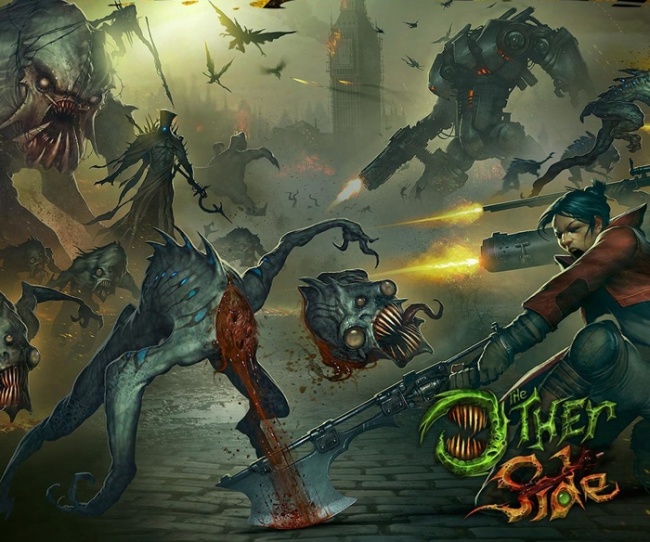
And that brings us to our second twist. Assets are reminiscent of Malifaux’s Upgrades. You attach them to a unit, and they provide a permanent effect – either a passive bonus, a new trigger, or an entirely new action. If a unit with Assets would take damage, it may flip an Asset over, disabling it, to negate the hit. That’s how Titans stick around through incoming fire. Some Assets come with a unit, others are purchased before the game, and still others may attach during the game.
The third twist is Tactics Tokens, which are reminiscent of Focus, Soulstones, or Command Points. You get two per turn, plus two for each surviving Commander (and some units generate them too). You can spend these to draw cards into your Fate Hand, one to one (since you don’t draw at start of turn automatically). There are a few other uses – disengaging without taking a disengaging strike, chain-activating two units in a row, getting a positive twist on a flip – but the biggest one is Stratagem cards. These are, basically, Stratagems, familiar to any 40k player; you pay the Tactics Token cost and draw the Stratagem card into your hand, where it sits until you choose to play it.
These are powerful effects, but limited. At the start of the game, you choose six available Stratagems and make a Stratagem deck. Once you use a Stratagem, in most cases it’s removed from the game entirely (although some return to your hand under specified conditions). Choosing when you can afford to buy the Stratagem card, and when to use it, are both key decisions.
I mentioned a fourth twist, and this is in my opinion the coolest part of The Other Side: Glory.
For the Glory of the King!
Every unit card in The Other Side is two-sided. Under certain conditions, a unit can “go to Glory.” When that happens, you flip the card over to the other side (get it?) and use that stat card for the unit from then on. Glory sides often have better stats, upgraded actions with new triggers and higher strength, and new actions and rules entirely. But they vary wildly – some units go to Glory and stay there, while others flip back and forth over the course of the game, like the Abyssinian Rail Gunner. One, the Breachling, immediately dies when it goes to Glory, in a cascading explosion sure to take nearby enemies with it.
Each faction has a unique means of going to Glory. Some models have an individual way of doing it, but mostly it’s faction-wide – for instance, King’s Empire units go to Glory by killing enemy Fireteams, while the Gibbering Hordes do it by literally eating each other. And some units are dual-faction, and thus go to Glory in different ways depending on what army you take them in.
Figuring out which of your units really need to be in Glory – and the best way to get them there – is a big part of the The Other Side, and it creates truly cinematic moments. A beleaguered Fireteam reaching down inside themselves and drawing on a well of strength they didn’t know they had to save the day… that’s the stuff long, rambling wargame stories are made of. And some of those are almost listenable. But when you do it, it’s a lot of fun, and all but the biggest sourpuss opponents will have to agree.
Armies of Earth
There are, at time of writing, four factions in The Other Side, along with two mini-factions, which act as mercenaries. Broadly, the game is divided into “Earth factions” vs. “Malifaux factions,” or “the good guys” vs. “the monsters.”
The King’s Empire
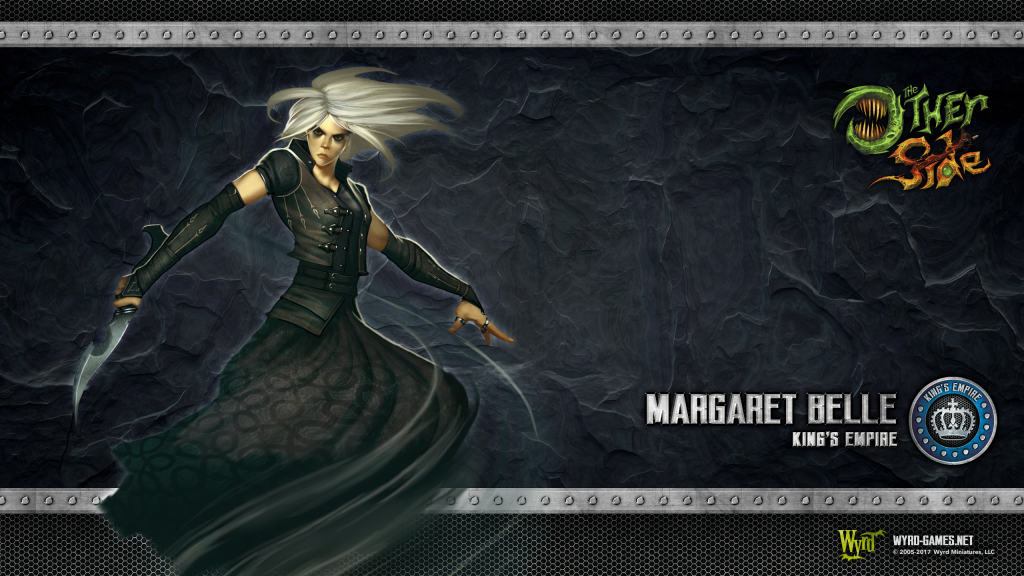
The United Kingdom, like most Earthside nations, has languished under the heel of the Guild for years. The Guild doesn’t exactly “rule the world,” but as the ultimate controllers of the world’s supply of Soulstone, the leading Minerva Council certainly has a thumb on the scales. The coming of the Burning Man has shaken things up, and nations that previously had to go along with whatever the Guild demanded are now making their own way. Britannia is one of these – the King’s Empire is ready to take its own destiny in hand and strike a blow against the savage Godless hordes (of Deep Ones and madness monsters).
Plucky Little England focuses on shooting, with platoons of riflemen and grenadiers. They’re not super high-tech – they rely on field artillery and regular bolt-action rifles, though apparently someone has invented a galvanically powered velocipede on which to mount a newfangled machine gun. Soulstone tech makes an appearance, though, in the massive King’s Hand mecha and the steam-powered fists of the South Wales Borderers, whose Remember Our Mates ability makes them more dangerous as they take wounds (and whose Incomprehensible Insults can goad enemies into unwise advances). King’s Empire units units go to Glory when they kill enemy Fireteams, and they have a variety of advantages to their ranged attacks, including the ability to shoot instead of making a melee attack after charging and even shoot in melee.
The Gibbering Hordes
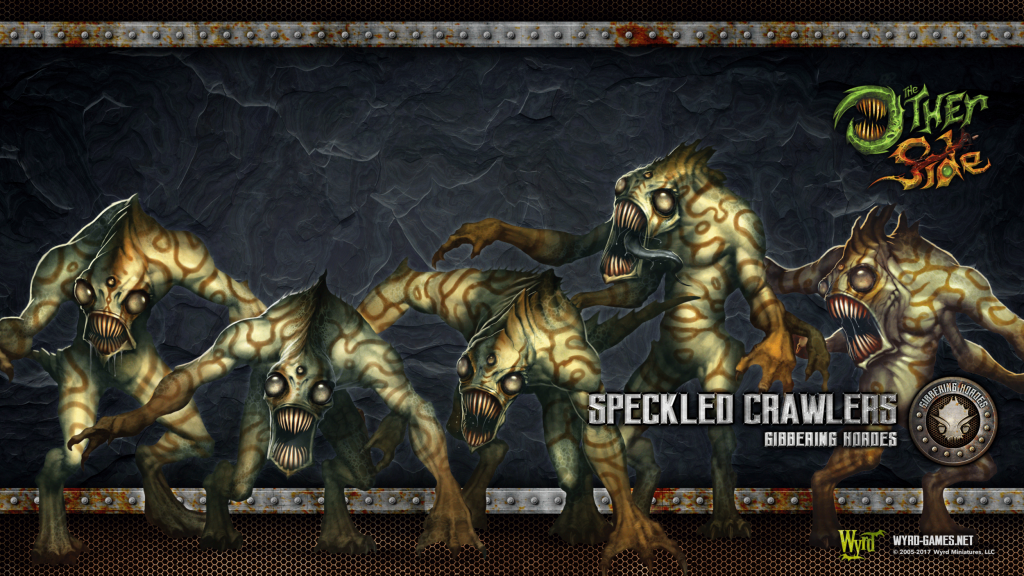
The Empire has had to deploy in force to counter the Gibbering Hordes – a collection of nightmarish monstrosities from Malifaux’s abyssal depths. The Hordes serve Meridion, an imprisoned Tyrant whose sphere of influence was Malifaux’s ley lines, and they resemble nothing so much as Deep Ones. From the gliding Yarazi to the heavily armored Whelks, they take a staggering array of forms, but all of them features fangs, spines, and nasty little beady eyes.
The Hordes are, well, a horde, and it shows in their playstyle. They can endlessly resummon dead units using Tactics Tokens, making grinding them down a fool’s errand. They’re not much on ranged attacks, focusing on melee, but that doesn’t mean you can just gun them down – before the game starts, they can drop 120mm Tide Pool terrain pieces onto the table, and use them to conceal their advances. Hordes eat each other to go to Glory, which is why you might hire Egg Clutches… they don’t do much (though if left alone they can hatch), but they’re cheap and easy to feed to your beefier troops. The Hordes also have some of the most unusual Commanders; the Frenzy is actually a unit of three shark-men, while Horomatangi is actually a Titan himself.
Abyssinia

Marching to the aid of the Empire are the Abyssinians. They’ve ended their seclusion and set out to save the world from the Guild’s mistake, powered by Soulstone and fierce national pride. Plus, war is an excellent chance to test prototype weaponry. Discus grenades, experimental rockets, shock batons, flare guns… these things won’t test themselves! Abyssinian troops are the best-equipped in the world, and that’s not even counting the mechanized legions that go to war with mechsuit backup.
Abyssinia focuses on combined arms and devastating high-tech weaponry. Before the game, you get two Prototype assets per commander and may distribute them among your units. These assets mostly give extra attacks, such as zeppelin bombardment or clouds of toxic chemicals. Abyssinian troops all gain two unique triggers on all actions – a tome trigger to draw a card, and a Margin Value 6 trigger to go to Glory. Six is a lot, but they have a lot of card draw, especially since every Abyssinian unit that dies also draws you a card… leaving your Tactics Tokens free for sweet plays. Finally, they may choose not to end the turn after passing twice, giving them unparalleled tactical flexibility. But really, if you’re playing Abyssinia, you’re in it for the cool tech – in addition to the quadrupedal Dreadnought, they have multiple units that come with a giant mech, like the cannon equipped Walker or the buzzsaw-wielding Cutter. Or you can just fire up a Rail Gunner and absolutely zorch one enemy unit out of existence.
Cult of the Burning Man
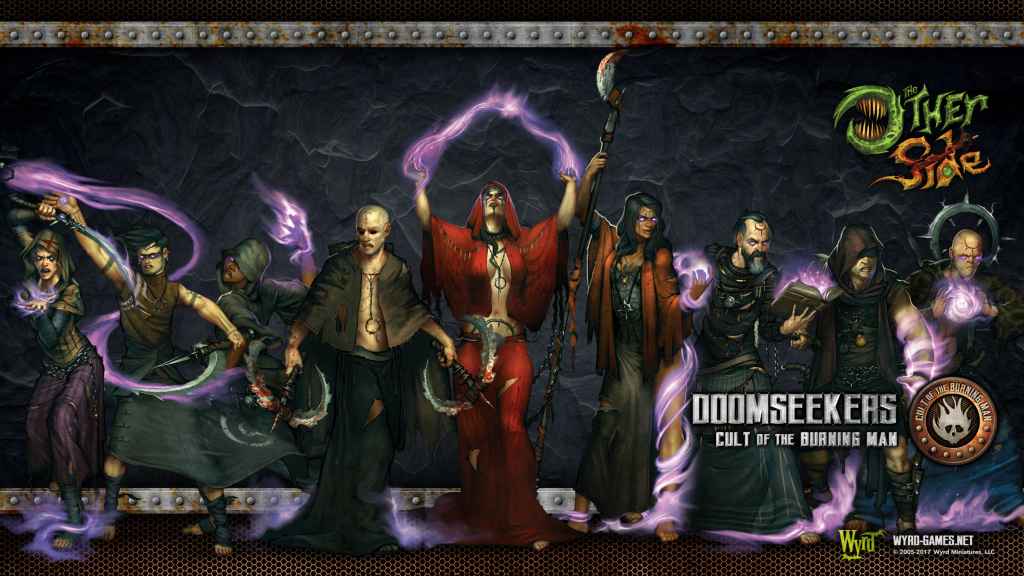
You’ll need that power when facing the Cult of the Burning Man – His mad followers draw strength from the chaotic energies that roil in His wake. Led by Adeodatos and his disciple Fenton Brahms, the Cult consists of the lost, the broken, and the mad – from the ECB Black Ops team that spirited Adeodatos out of prison to the Broken and Doomseekers who revel in his teachings. They can also call on those warped by the lunatic energies that radiate from the portals, such as the barely-human Twisted Horrors to the never-human Breachlings.
The Burning Man is known for the dimensional tears that open where He passes, and the Cult has learned to harness these portals. They place three 50mm Portal Markers at the start of the game, and can move them around during the course of the game. A friendly unit can hop from any portal to any other, giving them incredible maneuverability. The Cult also uses madness as a resource – you may place Shaken tokens on your own squads whenever an Ace goes to your discard pile, and any squad with two or more Shaken tokens may go to Glory at any time. They tend to have some of the weirdest and most unique units around, like the ECB Black Ops (a unit whose Fireteams can split up and act independently) and the Breachlings (who, when they go to Glory, explode in a devastating cascade of energy).
Finally, there are two mini-factions: the Guild, who can assist the King’s Empire and Abyssinia, and the ghost-enslaving Court of Two, who can hire on into the Cult or the Hordes. These are pretty small factions, with a limited array of models, and can be declared independently as well as serving as mercenaries if you want.
Sounds Great!
I know, doesn’t it?
Where Can I Get Started?
Well… this is the part that’s not as much fun to write.
You may have picked up from my word choice there that things didn’t go according to plan. Wyrd didn’t botch the Kickstarter – everything was delivered, everyone got their pledges. But The Other Side never made a splash. There are a lot of explanations for why – 2018 featured a global economic downturn, Malifaux was ending one edition and getting ready to head into another, but the 800-pound gorilla in the room was Warhammer. 2017-2018 were when Games Workshop, after several years of doldrums, really started firing on all cylinders again. Anyone who’s played wargames knows that GW goes through cycles, and when their products are good, they often suck up a lot of the oxygen in the room. The Other Side wasn’t a bad game, but it launched just as many people were coming back to Warhammer… and it had the extra bad luck of being a large-scale game, a direct competitor. Malifaux is a skirmish game and doesn’t really scratch the same itch as Warhammer, but The Other Side was trying to battle a titan, and it just didn’t work out.
The game isn’t dead, but it’s absolutely on life support. There are a few locals that play, but mostly you’ll have to play on Tabletop Simulator unless you can convince your group to pick it up. I’d definitely recommend at least trying that – the starter boxes are very good value, and the game is remarkably ahead of its time design-wise. It has design elements that showed up in later games like A Song of Ice and Fire, Crisis Protocol, and 8th edition 40k, all of which came out after The Other Side dropped. The ruleset is tight and fun, keeping some of what makes Malifaux fun while trying some other stuff that’s wholly new, and the models are gorgeous. There’s even an app, which is every bit as slick as the Malifaux app (which means it’s miles better than most of its competitors, while being free): https://toscompanybuilder.com/.
There are signs, though, that Wyrd is putting in the effort to give TOS another try. They recently launched a two-player starter box featuring the Guild and the Court, and all of the models in it are usable in Malifaux as well. They’ve also announced two new factions: the Three Kingdoms (Japan, China and Vietnam, which in this setting have formed an alliance to counter the power of the Guild) and the Kimon, a swarm of Oni from the realm of Beyond who plan to invade Earth to devour souls. I have a feeling that 2023 is going to be a busy year for The Other Side, and as someone who’s had his eye on an Abyssinian army since they were announced, I am just waiting for an excuse to pull the trigger.
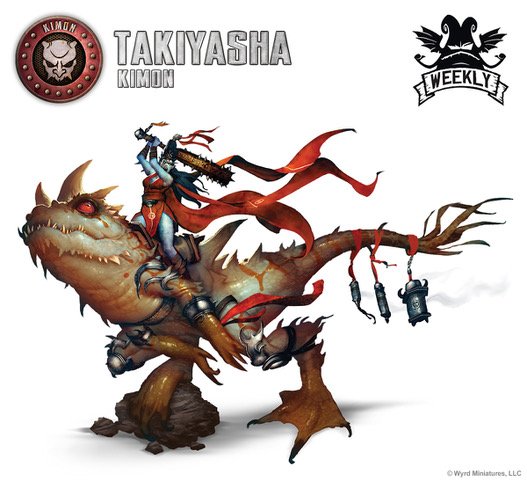
I hope this inspires you to check out The Other Side. Wyrd has some really talented designers and the game is solid enough that I am rooting for it to succeed. If you’re interested, or if you’ve got a regular playgroup, sound off in the comments! I want to hear about it.


